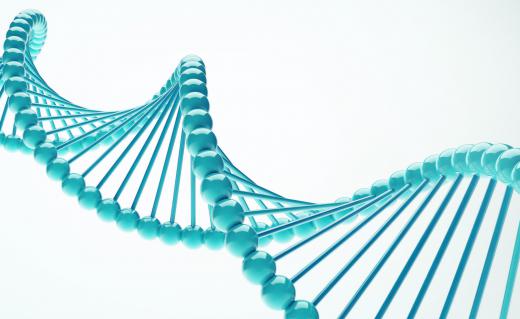What is a Zinc Finger?
A zinc finger is a finger-shaped protein fold that is formed by specific amino acids in the protein binding to a zinc ion. These proteins often bind to DNA and RNA because their shape allows close interaction of the domain with the nucleotides of DNA and RNA. Their nucleotide binding properties allow them to function in regulating gene expression and in virus assembly.
There are several types of zinc finger structures, but the most common version consists of an alpha helix and a beta sheet, the two most common secondary structures in proteins, on either side of at least one zinc ion. The alpha helix and beta sheet are held in position by cystine and histidine residues, coordinating the zinc ion via their nitrogen and sulfur atoms. The zinc finger binds to DNA, and through the interaction of amino acids at its periphery with base pairs at the center of the DNA double helix. It is a compact protein domain, and its small size allows it to have close proximity with DNA base pairs.

These proteins are the most common transcription factors in living organisms. A transcription factor is a protein that binds to DNA and controls the transfer of genetic information to RNA. The fact that these proteins to target DNA has made them candidates for purposeful re-engineering in order to target DNA sequences of interest.
For example, a Zinc Finger Nuclease (ZFN) is a synthetic protein that has an engineered zinc finger binding domain fused to a restriction endonuclease, or DNA-cleaving enzyme. The ZFN can be used to cut DNA at specific locations, and is a useful tool to promote site-specific recombination of DNA. Engineered zinc fingers can also be used as artificial transcription factors.
Zinc finger domains are found in some viral proteins, including the neocapsid (NC) protein of the Human Immunodeficiency-1 (HIV-1) virus. NC is an attractive antiviral target because it is important for viral assembly and is highly conserved. Inhibitors that specifically target the zinc fingers of viral and retroviral proteins could be used to prevent virus replication. Obtaining antiviral compounds of this nature is an active area of biomedical research.
These proteins play important roles in the normal metabolism of cells. To be effective, anti-retroviral compounds must specifically target retroviral zinc finger proteins. These retroviral proteins have distinct amino acid sequences and structural differences from cellular zinc finger proteins, so obtaining selective inhibitors is an achievable goal.
AS FEATURED ON:
AS FEATURED ON:











Discussion Comments
There was an article on this the other day. Apparently, scientists used zinc finger nuclease to delete the gene in mosquitoes that allow mosquitoes to digest blood. So the mosquitoes died of starvation.
I'm not sure how ZFNs are meant to be used, but I guess this could be one of their benefits- no more mosquitoes. It could help us wipe out some horrible diseases that mosquitoes love to pass on like malaria. How it would impact the ecosystem is another issue tough. I guess we still need to do some more research before we really put ZFNs to use.
@ysmina-- I don't know too much about this subject either. But I do know that zinc finger domains are very important when it comes to genetic illnesses. Zinc finger domains allow scientists to manipulate DNA. I think that itself is truly amazing.
If scientists can easily manipulate DNA, they can also manipulate something called gene expression. Just because someone has a gene for an illness, for example, doesn't mean that they have to suffer from it. Scientists can potentially turn that gene off and genetic illnesses can be prevented before they turn into reality.
Of course, you still carry that gene and so will you children and their children. So I imagine that each individual will require separate treatment. But as long as we can manipulate DNA with the help of zinc finger domains, I think it will be worth it.
As someone who has genetic diseases in her family history, I'm very interested in learning about what scientists are studying and doing in this area. I had heard about breaking up DNA and making recombinant DNA (RNA) to treat various diseases, but I hadn't heard about the presence and importance of zinc fingers in doing that.
I'm surprised to know that it is found in the HIV virus as well. If we learn more about zinc fingers in the HIV virus and how we can target it, does this mean that we can we treat HIV altogether?
Are zinc fingers just one factor that scientists need to look into? If we place more emphasis on studies about zinc fingers, will that bring us closer to treating these various diseases?
Post your comments